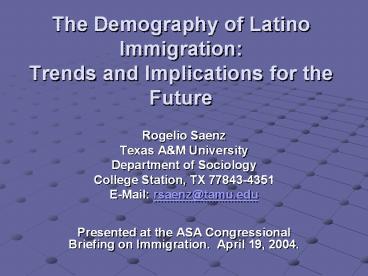The%20Demography%20of%20Latino%20Immigration:%20Trends%20and%20Implications%20for%20the%20Future - PowerPoint PPT Presentation
Title:
The%20Demography%20of%20Latino%20Immigration:%20Trends%20and%20Implications%20for%20the%20Future
Description:
The Demography of Latino Immigration: Trends and Implications for the Future Rogelio Saenz Texas A&M University Department of Sociology College Station, TX 77843-4351 – PowerPoint PPT presentation
Number of Views:146
Avg rating:3.0/5.0
Title: The%20Demography%20of%20Latino%20Immigration:%20Trends%20and%20Implications%20for%20the%20Future
1
The Demography of Latino ImmigrationTrends and
Implications for the Future
- Rogelio Saenz
- Texas AM University
- Department of Sociology
- College Station, TX 77843-4351
- E-Mail rsaenz_at_tamu.edu
- Presented at the ASA Congressional Briefing on
Immigration. April 19, 2004.
2
Unique Features of Latino Immigration
- Sustained immigration throughout 20th century.
- Mexican prominence in U.S. foreign-born
population. - Major impact of Latino immigration on the
demography of the U.S. - Historical context surrounding Mexican and Latin
American immigration to the U.S.
3
Demographic Trends Related to Latino Immigration
- Population Changes
4
(No Transcript)
5
(No Transcript)
6
(No Transcript)
7
Demographic Trends Related to Latino Immigration
- Ten Fastest Growing States in Latino Population
Between 1990 and 2000. - North Carolina (394)
- Arkansas (337)
- Georgia (300)
- Tennessee (278)
- Nevada (217)
- South Carolina (211)
- Alabama (208)
- Kentucky (173)
- Minnesota (166)
- Nebraska (155)
8
Demographic Trends Related to Latino Immigration
- Changes in Distribution Patterns of Latino
Immigration - Latinoization/Mexicanization of U.S.
9
(No Transcript)
10
(No Transcript)
11
Demographic Trends Related to Latino Immigration
- Age/Sex Composition of Latino Immigrants
- Median Age in 2000
- Latino Foreign-Born (33)/Native-Born (18)
- Mex. Foreign-Born (31)/Native-Born (16)
- U.S. Population (35)
- U.S. Non-Latino White (38)
- Sex Ratio (Males per 100 Females) in 2000
- Latino Foreign-Born (113)/Native-Born (100)
- Mex. Foreign-Born (126)/Native-Born (102)
- U.S. Population (96)
- U.S. Non-Latino White (96)
12
(No Transcript)
13
(No Transcript)
14
Trends in the Labor Patterns of Latino Immigrants
- Labor Force Participation Rates
15
(No Transcript)
16
Trends in the Labor Patterns of Latino Immigrants
- Gender and Work
17
(No Transcript)
18
Trends in the Labor Patterns of Latino Immigrants
- Latino Immigrant Industrial Niches
- 20 industries where Latino immigrants
disproportionately represented with a specific
volume of Latino immigrant workers in the
industry. - Nearly half (47.3) Latino immigrant workers
employed in these 20 industries.
19
Trends in the Labor Patterns of Latino Immigrants
- Latino Immigrant Industrial Niches
- Top Ten Latino Immigrant Industrial Niches on
Basis of Number Workers - Construction
- Restaurants and other food services
- Fruit vegetable preserving spec. food mfg.
- Landscaping services
- Traveler accommodation
- Services to building and dwellings
- Private households
- Automotive repair and maintenance
- Groceries related product wholesalers
- Not specified manufacturing industries
20
(No Transcript)
21
(No Transcript)
22
The Special Case of Mexicans and Length of U.S.
Residence
- Population 25-44 Years of Age
- Period of Arrival in the U.S.
- Before 1970 1970-1979 1980-1989 1990-2000
- With increasing time in the U.S., Mexican
immigrants have. - higher rates of naturalization.
- higher rates of English fluency.
- higher rates of female labor force participation.
- higher presence in higher-status occupations.
- higher labor market wages.
- lower poverty rates.
23
Broad Trends in Latino Immigration and
Implications for the Future
- Population projections and the increasing
Latinoization of the U.S. - 2000 12.6
- 2010 15.5
- 2020 17.8
- 2030 20.1
- 2040 22.3
- 2050 24.4
- Source U.S. Census Bureau. 2004. U.S. Interim
Projections by Age, Sex, Race, and Hispanic
Origin. Washington, DC U.S. Census Bureau.
24
Broad Trends in Latino Immigration and
Implications for the Future
- Latino immigration and impact on societal
institutions. - Latino immigration and the blurring of
boundaries. - Transnational migration
- Remittances
- Nationality/Citizenship
- Geography
- Family
- Nativity Status
- Language































